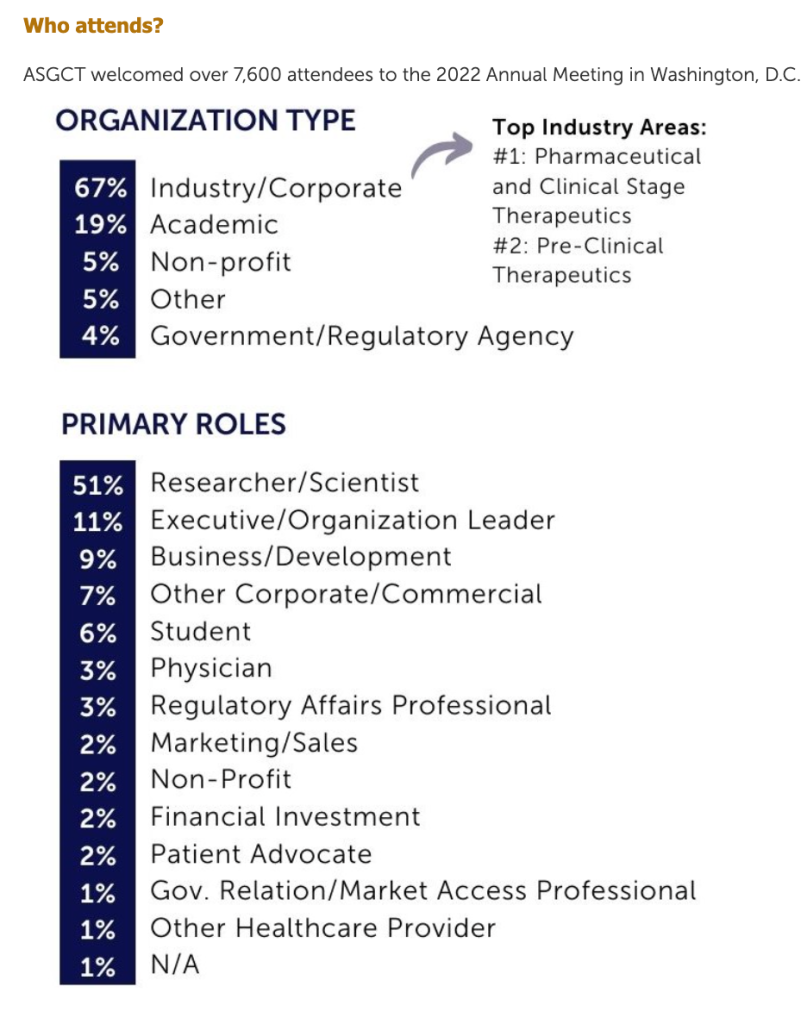FAST attends the American Society of Gene & Cell Therapy’s annual scientific meeting
Last week, members of FAST’s scientific team attended the American Society of Gene & Cell Therapy’s (ASGCT) annual scientific meeting. This is the largest gene and cell therapy conference in the world with over 8000 brilliant minds estimated to be present, all coming together to improve genetic therapies for patients! The team was excited to meet like-minded individuals and share the recent advances in Angelman syndrome drug development with those working at the cutting edge.

By creating awareness and visibility in these arenas the most innovative collaborations are created, adding novel advancements to our ecosystem.
Dr. Nycole Copping, our science director, one of the FAST team members in attendance, found the Angelman research strategy to fit right in with all of the work being done around the globe. Here are just a few of Nycole’s highlights:
- After listening to 5 days of in-depth science and discovery, Nycole was so proud to realize that FAST has already thought about, explored, and recruited teams to address nearly all of the issues that still face gene and cell therapies for rare disorders like AS, keeping AS at the forefront. She was again, super impressed that the Angelman community is in sync with every significant topic covered at such an innovative international meeting.
- FAST was given center stage at such a prestigious scientific conference, being invited to speak about the promise and challenges of advancing innovative gene and cell therapies for diseases like Angeman syndrome. We were able to share insights through the Angelman syndrome lens of what symptomatic changes would be considered meaningful and transformative for a disorder like AS in the lives of families and patients. We highlighted the need for all stakeholders to work together to understand what “transformative” might mean to parents and families living with these rare neurodevelopmental disorders, which is often not simplistic or black and white.
The patient and parent voice must be heard loud and clear in these discussions, a theme that was well highlighted and acknowledged by the panel. We were able to walk the audience through the journey our families take every day with AS, while highlighting the challenges and promise of creating transformative therapies for every individual. Since FAST’s inception, scientific collaboration has been key to advancing all shots on goal, with any modality that has promise.
The infinite power of our parents, caregivers, scientists, clinicians, industry partners, and advocacy partners all working together to advance drug development was on full display. The audience was incredibly impressed that we are not stopping at a single modality but working to ensure that we have multiple options for the long-term and continue not to put all our “eggs in one basket.”
One humbling take-home message in this session was focused on the fact that FAST is a stellar example of a rare disease organization, but there are tremendous inequities of most other rare disease organizations around the world that don’t have the bandwidth to accomplish a similar output. Many important and vital questions were raised throughout the session, highlighting the need for those in the field of cell and gene therapy to help figure out how to make drug development more equitable for the long-term success of all rare disease communities, as the strides made in Angelman syndrome is not easy to replicate.
- It is critical that the patient voice is included at these conferences to remind scientists, pharmaceutical companies, and manufacturing teams of patient and caregiver perspectives and preferences for treatments. The path FAST has taken from academic labs to the clinic was eye-opening to both academics and industry, who are desperately trying to do the same. Many are unaware of the crucial role advocacy groups like FAST play in drug development. Patient organizations have an evolving role in drug development, from conducting proof-of-concept studies to promoting new drug discovery and ensuring clinical trial readiness for their respective diseases. The level of engagement and interaction we received during this meeting from colleagues present was awe-inspiring.
- It was amazing to see the advances in brain delivery for gene therapy with the discovery of new capsids targeting the brain, and new non-viral delivery vehicles. Though it was also clear that there is a long regulatory path to get these “never tested” biologics to humans. The teams at this scientific meeting are the teams pushing them as fast as they can.
- We learned about new drugs that can be used to lower neutralizing antibodies of AAV, which could have great implications in dosing individuals with pre-existing antibodies to AAV, who could have potentially been excluded from clinical trials or gene therapy treatment, and for the potential for re-dosing of patients with higher doses or next-generation gene therapies after they develop antibodies to the original gene therapy viral vector. This was a very exciting discussion.
- Nycole was able to connect with many brilliant minds that have great ideas and want to leverage their discoveries for Angelman syndrome and get more involved with FAST.
- Overall, it was networking, learning, teaching at its finest!!!